Note: This page has been updated to adjusts costs to reflect 2011 dollars.
The major advantage of LRT is that its capacity is high enough for most every outer corridor within the GTA for today and for well beyond the foreseeable future. Furthermore, the capacity of one Subway line can be exceeded with two parallel LRT lines with numerous advantages:
- a single rapid transit line requires funneling all users to the single line; while feeder bus routes would be ideal, the reality is that many new users will drive to this single line and will require parking; stations must be built with giant parking facilities
- when a service disruption occurs, the entire corridor served by a single line is affected, with little or no alternatives
- single lines involve single point-to-point operation; few, if any, opportunities exist for route interlining that can provide service that provides more convenient travel options for users with a reduced need to transfer in order to reach one's destination
As will be shown here, the construction cost of LRT is so significantly lower than Subway construction that in some cases it is possible build TWO, or even THREE parallel lines for a similar cost, often reaching further destinations.
Imagine this comparison the York Region corridor around Yonge Street:
- One single rapid transit line down Yonge Street
- A rapid transit line on Leslie/Don Mills, one on Yonge, and a third on Dufferin
In case 1, everyone must get to Yonge. Those close enough could walk, or they would take a feeder bus. Those west of Bathurst or east of Bayview will be more likely to drive and need parking. When an incident occurs on this line, EVERYONE from this corridor is stuck.
In case 2, it might sound as if three times the stations spread over the three lines will each require parking facilities that are only a third of the facilities needed for the single Yonge line. However, with more stations spread over a wider catchment area, far more people are in a position to walk or use a feeder bus service to reach the rapid transit line, so the total parking requirements will be lower. It is possible that the parking requirements would be the same because the multiple lines will attract even more riders over a wider area. This means that for the same amount of money, far more people will reap the benefits of this investment in public transit.
Just how real is this 3-for-1 idea? Let us look a the sort of costs for building Subway and LRT lines. Please note: since the primary purpose of this site is to show the benefits of LRT, to avoid the accusation of taking the best of LRT costs and comparing them to the worst of Subway costs, we will attempt to do the exact opposite. In coming up with these figures, every allowance and benefit of doubt has been given to Subway figures, while attempting to be as critical as possible with LRT figures.
Many have the belief that Subways are expensive simply because the are underground.
This is a major increase in the cost of construction, for building underground is more expensive than building at grade. Even building an elevated structure tends adds to cost, though not quite as much as a tunnel.
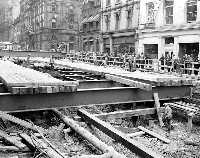
However, it is not just the underground issue that makes Subway more expensive - it is the whole infrastructure around a Subway that makes it more expensive. The ROW must be completely isolated. This means that when it is able to run on the surface, it requires more space, and must be totally fenced or walled in to prevent any public access. All street crossings must be grade separated.
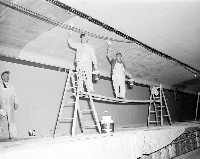
Station infrastructure is more costly. Think about what costs more: a station that must have stairs, escalators, and elevators to go up or down to a level to be able to cross tracks, or a station that allows crossing the tracks on foot?
When tunnels and other structures are built for Subway, they are more costly due to the larger loading gauge (height and width clearances for vehicles). The greatest effect of this is the extra space needed for curves and cross-overs.
As you will see, the cost range for building LRT underground is actually comparable to building a Subway at grade.
| Car type | Seats | Standees |
| Bombardier/TTC T1 | 66 | 184 |
| Bombardier FLEXITY 2 | 64 | 115 |
The loading gauge of an LRV is reduced not only by the narrower dimension, but articulated design allows the longer vehicle to negociate tighter curves. The overall costs for a tunnel for an LRT line are often less costly than a tunnel for Subway. The cut-and-cover work needed at cross-overs is reduced when an LRT line is tunneled and this also translates into less disruption in the neighbourhood during construction.
Another added cost for Subway is that it requires a complex signaling infrastructure compared to LRT. The benefit is that Subway can make use of Automatic Train Control (ATC) because it already needs this signaling infrastructure.
Underground: $250 million to $300 million per kilometre
At grade: $150 million to $200 million per kilometre (roughly 65-70% of the underground cost)...plus the cost of vehicles. Note that stations are typically 1.5 to 2 km apart - more stations drive up costs.
Since Toronto has recent examples of constructed and proposed Subway construction, it is easy to find reasonably recent figures. Despite this, the estimates stated above are LOWER than the estimated costs outlined here. Only the construction of the Sheppard line, taking inflation into mind, falls within the range above at $172 million per kilometre.
Spadina-York Extension: $275.6 million per kilometre, vehicles and yard improvements excluded
The extension from Downsview station to a station in the Vaughan Corporate Centre (VCC) in the Highway 7 and Jane Street area is budgeted at approximately $2.6 billion (2010 dollars). As this extension is 8.6 km, that makes the cost per kilometre about $302 million.
This figure includes the purchase of 36 subway cars and improvements to Wilson Yard. The amount for these were $108 million and $85 million respectively in 2005 dollars according to the Environmental Assessment on the extension to Steeles. This comes to $229.3 million in 2011 dollars. Removing this from the $2.6 billion project budget leaves $2.37 billion, or a per kilometre cost of $275.6 million.
Sheppard East Extension Proposal: $273.1 million per kilometre
In March of 2003, the TTC issued a report that outlined the costs of extending the Sheppard line from Don Mills to Scarborough Town Centre. This extension would have added 7 stations over a distance of 8 km for an estimated cost of $1.75 billion, or about $218.75 per kilometre. Factoring in inflation, this is about $273.1 million per kilometre for the whole line. That makes the full cost of this expense in 2011 dollars to be $2.18 billion for the line, which does not include a western extension to Downsview nor the completion of a station at Willowdale, as in Rob Ford's vision.
This extension would have opened in three stages:
- Don Mills to Victoria Park: 2 km with two stations for $470 million ($293.4 million / km in 2011 dollars)
- Victoria Park to Agincourt (GO Station): 3.7 km with three stations for $730 million ($246.3 million / km in 2011 dollars)
- Agincourt to STC: 2.3 km with two stations for $550 million ($298.6 million / km in 2011 dollars)
It was not stated in the report if any of these costs included the purchase of new vehicles.
Bloor West Extension Proposal: $270.3 million per kilometre
One other proposal from a few years ago was to extend the Bloor-Danforth Subway line beyond Kipling. This was to involve a 3.7 km extension to the Queensway/West Mall area for a cost of about $1 billion. This translates to $270.3 million per kilometre.
A further extension of 1.5 km from there to Dixie in Mississauga was estimated to cost another $500 million, making that piece a whopping $333 million per kilometre!
Both of these extensions would have been at grade, not tunneled! Typical at-grade subway construction tends to be about 65-70% of the tunneled cost, so the estimates of this proposal seem quite excessive.
Underground: $130 million to $225 million per kilometre
At grade in concrete: $50 million to $60 million per kilometre
At grade with ballasted ties: $30 million to $40 million per kilometre...including the cost of vehicles.
As Toronto has not embraced LRT construction until the release of the Transit City plan, it is necessary to look at other cities.
The summary for each example has had annually compounded inflation added to the actual cost at a rate of 2.5% to make a fair comparison with 2011 dollars. All costs quoted were converted to Canadian dollars using an approximate exchange rate in effect when the line was completed (stated in each case).
Transit City Eglinton Crosstown Line Line: $55 million per kilometre for surface, $269 million per kilometre tunneled
Phase one of this line is 19 km long with 27 stops from Jane to Kennedy. The full line is to be 33 km with 43 stops from Pearson Airport to Kennedy with funding for this line at $4.6 billion from the province. Approximately 13 km between Keele and Laird will be underground.
This averages to about $139.4 million per kilometre. If one were to use $55 million per kilometre as an estimate for the surface portion, that would make the tunneled portion about $269 million per kilometre.
In actual fact, the Don Mills station and the interface at Kennedy will be underground. If these costs were also removed from the total along with the surface amount, the per kilometre cost for the tunneled portion will be somewhat lower.
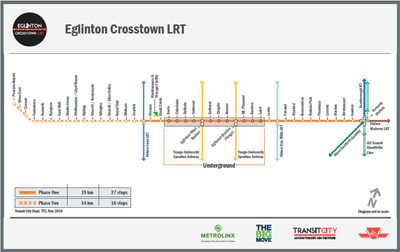
Transit City Sheppard East Line Line: $56.7 million per kilometre
Phase one of this line is 12 km long with 30 stops from Don Mills to Morningside. The funding for this line totals to $930 million ($613 million from the province, and $317 million from the federal government).
Approximately $250 million of this is the cost of the underground portion from Don Mills to Consumers. This is approximately 1 km of tunnel construction, with a somewhat deep interface with the Sheppard Subway to provide a same platform transfer.
Taking the remaining $680 million in funding, that translates to $56.7 million per kilometre. This includes the cost of the grade separation at the Agincourt GO station as well as the cost of vehicles, but does not include the cost of the maintenance facility.
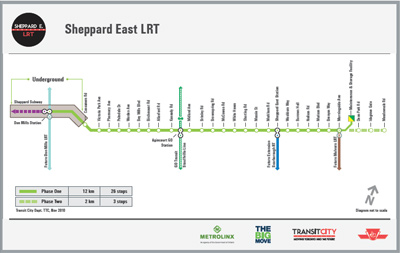
Transit City Etobicoke Finch West Line: $50-70.6 million per kilometre
Phase one of this line is 11 km long with 20 stops from Humber College to Keele.
The full line is to be 17 km with 30 stops from Humber College to Yonge Street. Funding for this line was set at $1.2 billion, but this amount included an eastern extension to Sheppard and Don Mills (approximately an additional 7 km).
The connections with both the Spadina Subway at Keele and Yonge Subway are to be underground.
If one considers the length of the eastern extension, this line is $50 million per kilometre. Assuming the full $1.2 billion is needed just to go to Yonge, the cost is $70.6 million per kilometre.
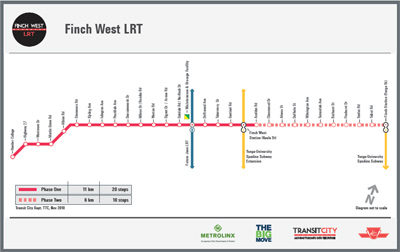
Denver's T-REX project: $41.5 million per kilometre, 34 new vehicles included
The whole T-REX project involved new LRT construction in the south-east portion of the city plus freeway expansion. The costs of the LRT construction was US$879 million for 30.4 km of new lines and 13 new stations. Added to this was US$91.8 million for 34 new LRVs. This made the total cost US$970.80 - adding in 2.5% for inflation since this line opened at the end of 2006, then adding 15% for the exchange rate in effect at the time, this cost in Canadian dollars is about $1.144 billion.
That makes the per kilometre cost only $41.5 million, and that includes vehicles!

Added to this, a significant amount of this new construction had elevated structures (see photo) to take the line over main roads, and all but one of the new stations has parking facilities, with several of the stations having a multi-level parking garage.
This entire extension was built with ballasted tie construction, which helps keep the cost down.
St. Louis: $35.7 million per kilometre, vehicles included
The initial construction in St. Louis cost US$465 for 27.4 km of line with 17 stations, including 31 vehicles. Most of this line is at grade, with 2.4 km elevated near the airport and the downtown section was built through an existing railway tunnel. The line crosses the Mississippi River using an already existing bridge. This fully opened in 1994, making the inflation-adjusted cost in Canadian dollars about $887 million (35% exchange rate).
That makes the per kilometre cost only $35.7 million in 2011 dollars.
St. Louis St. Clair County extension to Shiloh-Scott: $21.6 million per kilometre, no vehicles included
This 5.6 km extension added 1 station in 2003 for a cost of US$75 million. The inflation-adjusted cost in Canadian dollars was about $110.3 million (30% exchange rate).
That makes the per kilometre cost only $21.6 million in 2011 dollars.
It should be noted that much of this portion of the line is in rural territory where ballasted tie construction is used for the track. This likely contributes to the low cost of construction.

St. Louis Cross-County extension: $66.5 million per kilometre, no vehicles included
This 13 km branch line added 9 stations in 2006 for a cost of US$686 million. Portions of this line are elevated, almost 2 km is tunneled and the rest is in a fenced ROW. The inflation-adjusted cost in Canadian dollars was about $865 million (with a 20% exchange rate).
That makes the per kilometre cost $66.5 million in 2011 dollars.
Minneapolis Hiawatha Line: $53.7 million, 24 vehicles included
This 19.2 km line has 17 stations including one in a tunneled section at the airport. Fully opened at the end of 2004, the total cost of US$715.3 million included 24 LRVs and a servicing facility. The inflation-adjusted cost in Canadian dollars was about $935.7 million (20% exchange rate).
That makes the overall average per kilometre cost $53.7 million in 2011 dollars.
Edmonton LRT Expansion to NAIT: $224 million per kilometre, with 0.7 km underground
Currently under construction, this 3.1 km extension from Churchill Station to the Northern Alberta Institute of Technology will include 700 metres of tunnel and adds three new stations (all at grade). The tunneled portion interfaces with the existing tunneled portion of the LRT system, thus adding to the cost of the project.
The project was costed in 2008 at $815 million, including 10 new LRVs, and $70 million for land acquisition. That makes construction of the line about $695 million, or about $224 million per kilometre.
Add your comments on the LRT BlogThis page last updated January 24, 2012